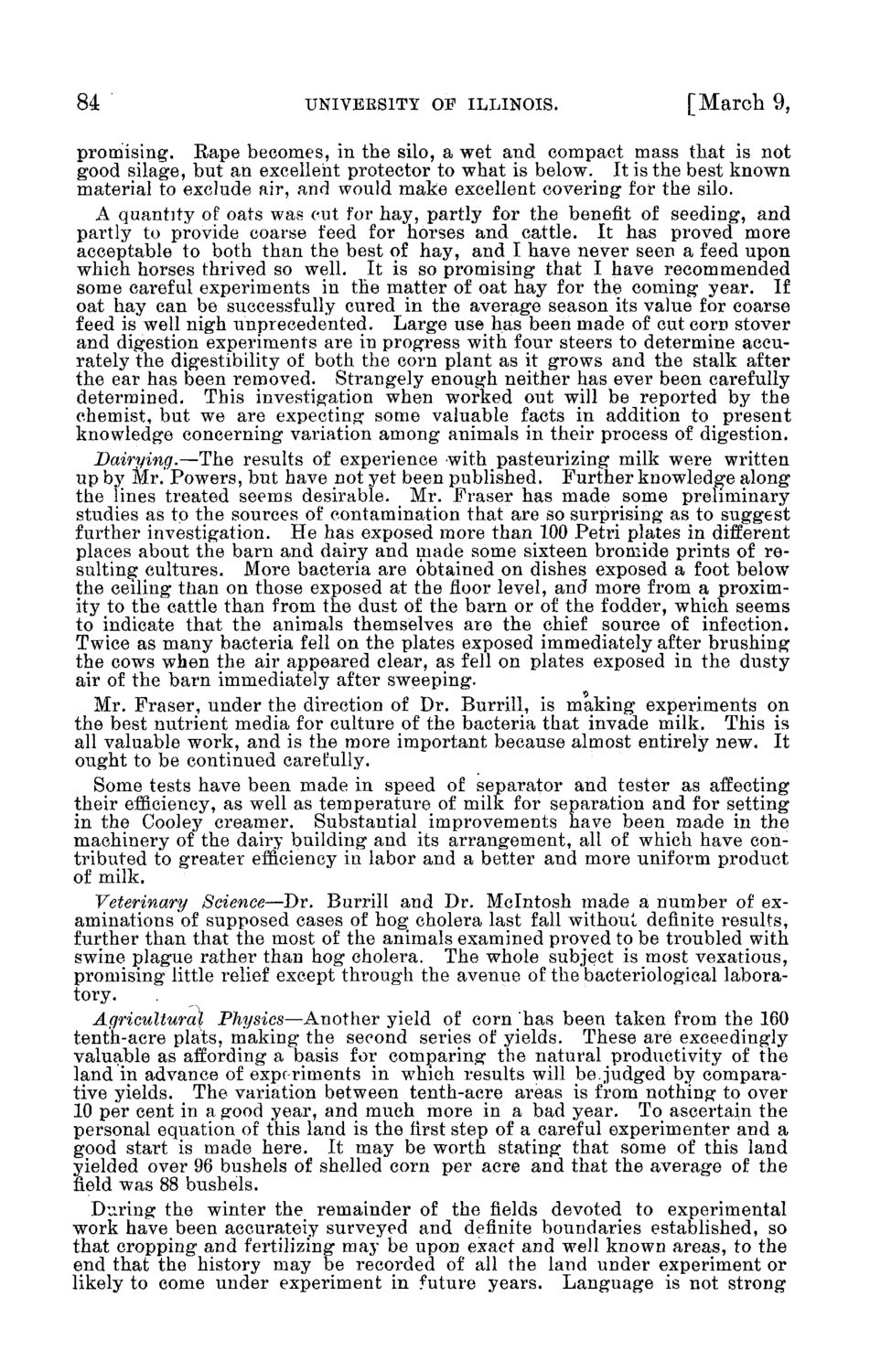| |
| |
Caption: Board of Trustees Minutes - 1898
This is a reduced-resolution page image for fast online browsing.

EXTRACTED TEXT FROM PAGE:
84 UNIVERSITY or ILLINOIS. [March 9, promising. Rape becomes, in the silo, a wet and compact mass that is not good silage, but an excellent protector to what is below. It is the best known material to exclude air, and would make excellent covering for the silo. A quantity of oats was cut for hay, partly for the benefit of seeding, and partly to provide coarse feed for horses and cattle. It has proved more acceptable to both than the best of hay, and I have never seen a feed upon which horses thrived so well. It is so promising that I have recommended some careful experiments in the matter of oat hay for the coming year. If oat hay can be successfully cured in the average season its value for coarse feed is well nigh unprecedented. Large use has been made of cut corn stover and digestion experiments are in progress with four steers to determine accurately the digestibility of both the corn plant as it grows and the stalk after the ear has been removed. Strangely enough neither has ever been carefully determined. This investigation when worked out will be reported by the chemist, but we are expecting some valuable facts in addition to present knowledge concerning variation among animals in their process of digestion. Dairying.—The results of experience with pasteurizing milk were written up by Mr. Powers, but have not yet been published. Further knowledge along the lines treated seems desirable. Mr. Fraser has made some preliminary studies as to the sources of contamination that are so surprising as to suggest further investigation. He has exposed more than 100 Petri plates in different places about the barn and dairy and made some sixteen bromide prints of resulting cultures. More bacteria are obtained on dishes exposed a foot below the ceiling than on those exposed at the floor level, and more from a proximity to the cattle than from the dust of the barn or of the fodder, which seems to indicate that the animals themselves are the chief source of infection. Twice as many bacteria fell on the plates exposed immediately after brushing the cows when the air appeared clear, as fell on plates exposed in the dusty air of the barn immediately after sweeping. Mr. Fraser, under the direction of Dr. Burrill, is making experiments on the best nutrient media for culture of the bacteria that invade milk. This is all valuable work, and is the more important because almost entirely new. It ought to be continued carefully. Some tests have been made in speed of separator and tester as affecting their efficiency, as well as temperature of milk for separation and for setting in the Cooley creamer. Substantial improvements have been made in the machinery of the dairy building and its arrangement, all of which have contributed to greater efficiency in labor and a better and more uniform product of milk. Veterinary Science—Dr. Burrill and Dr. Mcintosh made a number of examinations of supposed cases of hog cholera last fall without definite results, further than that the most of the animals examined proved to be troubled with swine plague rather than hog cholera. The whole subject is most vexatious, promising little relief except through the avenue of the bacteriological laboratory. Agricultural Physics—Another yield of corn'has been taken from the 160 tenth-acre plats, making the second series of yields. These are exceedingly valuable as affording a basis for comparing the natural productivity of the land in advance of experiments in which results will be.judged by comparative yields. The variation between tenth-acre areas is from nothing to over 10 per cent in a good year, and much more in a bad year. To ascertain the personal equation of this land is the first step of a careful experimenter and a good start is made here. It may be worth stating that some of this land yielded over 96 bushels of shelled corn per acre and that the average of the field was 88 bushels. During the winter the remainder of the fields devoted to experimental work have been accurately surveyed and definite boundaries established, so that cropping and fertilizing may be upon exact and well known areas, to the end that the history may be recorded of all the land under experiment or likely to come under experiment in future years. Language is not strong
| |